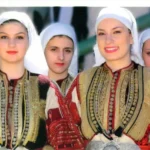Albania, a small yet culturally vibrant country in the Balkans, boasts a stunning array of traditional clothing that reflects its rich history, regional diversity, and enduring customs. Each piece of Albanian attire tells a story of resilience, artistry, and identity, making it a symbol of national pride and heritage.
Historical Roots of Albanian Traditional Clothing
Albanian clothing has evolved through centuries of cultural exchanges and local innovations. Influenced by the Ottoman Empire, Byzantine traditions, and regional practices, these garments reveal a fascinating blend of styles and techniques.
Origins in Antiquity
- 🏺 Illyrian Influences: Early Albanian attire traces its roots to the Illyrians, with simple garments made of wool and linen.
- 🐑 Woolen Textiles: Sheep farming provided high-quality wool, forming the basis of traditional clothing.
Ottoman and Byzantine Impact
- 🕌 Elaborate Embroidery: Ottoman rule introduced intricate embroidery and rich fabrics like silk and velvet.
- ✨ Gold Threading: Wealthy families often adorned their attire with gold and silver thread, showcasing status and artistry.
Post-Ottoman National Revival
In the 19th century, Albanian clothing became a symbol of resistance and identity, with regional styles emphasizing cultural pride.
Key Elements of Albanian Traditional Clothing
For Women
- 👗 Fustanella: A pleated skirt worn over colorful undergarments, common in the southern regions.
- 🧥 Xhubleta: A bell-shaped skirt with intricate patterns, typical in northern Albania.
- 🧣 Headscarves: Often embroidered and tied in distinctive styles based on regional traditions.
- 💎 Jewelry: Silver necklaces, earrings, and bracelets adorned women’s outfits, symbolizing prosperity.
- 👠 Shoes: Leather slippers or sandals completed the ensemble.
For Men
- 🩳 Fustanella: A knee-length pleated skirt paired with a waistcoat.
- 🧥 Qeleshe: A traditional felt cap, symbolizing national identity.
- 🪡 Vest and Jacket: Embroidered with geometric patterns and vibrant colors.
- 👞 Leather Shoes: Durable and often handmade, reflecting artisanal craftsmanship.
- 🎽 Sash or Belt: Used to secure the waist and carry small items.
Accessories and Craftsmanship
- Silver Ornaments: Men and women wore silver belts, buckles, and brooches.
- Handwoven Textiles: Artisans crafted vibrant shawls and sashes with intricate patterns.
- Natural Dyes: Bright hues came from plant-based dyes, adding vibrancy to garments.
Regional Variations in Albanian Clothing
Northern Albania
- 🏔️ Xhubleta Skirts: Unique to this region, featuring complex patterns and symbolic motifs.
- 🧥 Woolen Coats: Designed for warmth and practicality in mountainous climates.
Southern Albania
- 🌞 Brightly Colored Fustanella: A hallmark of the south, paired with richly embroidered vests.
- 🧣 Silk Scarves: Women adorned themselves with luxurious silk headscarves.
Central Albania
- 🌿 Simpler Designs: Central regions favored understated patterns and neutral tones.
- 🧥 Tailored Coats: Embellished with modest embroidery for formal occasions.
Traditional Clothing in Albanian Celebrations
Weddings
- 💍 Bridal Attire: Brides wear elaborately embroidered dresses, often in red and gold.
- 🎉 Groom’s Outfit: Includes a fustanella and vest, with detailed embroidery.
- 💃 Festive Garments: Guests wear regional attire to honor their heritage.
Festivals and Folk Dances
- 🥁 Traditional music and dances, such as the Valle, feature performers in full traditional attire.
- 🌟 Brightly colored garments enhance the visual spectacle of cultural celebrations.
Religious Ceremonies
- 🕌 Traditional clothing is often worn during key religious events.
- ✝️ Christian and Muslim communities incorporate their attire into ceremonies, showcasing cultural harmony.
The Craftsmanship Behind Albanian Clothing
Materials
- 🐑 Wool: A cornerstone of Albanian textiles, prized for its durability.
- 🌾 Linen: Used for lighter garments in warmer regions.
- 🕊️ Silk and Velvet: Reserved for ceremonial and festive wear.
Artisanal Techniques
- Embroidery: Regional patterns often depict symbols of nature, family, and resilience.
- Weaving: Handwoven fabrics highlight the skills passed down through generations.
- Metalwork: Silver and gold threading adds elegance to ceremonial attire.
Preserving and Revitalizing Traditional Albanian Clothing
Cultural Festivals
Events like the Gjirokastër Folk Festival celebrate Albania’s heritage, with participants showcasing regional attire.
See also Traditional Clothing in North Macedonia: A Celebration of Cultural Diversity
Traditional Clothing in North Macedonia: A Celebration of Cultural DiversityMuseums and Exhibits
Institutions such as the National Historical Museum in Tirana preserve and display traditional garments.
Modern Adaptations
Contemporary designers incorporate traditional patterns and materials into modern fashion, keeping the heritage alive.
A Living Legacy of Albanian Identity
The traditional clothing of Albania is more than just fabric and thread—it’s a vibrant testament to the country’s history, culture, and enduring spirit. Whether seen in festivals, museums, or modern designs, these garments remain a cherished part of Albania’s identity, bridging the past with the present and inspiring future generations.
See also Traditional Clothing in Montenegro: A Testament to National Identity
Traditional Clothing in Montenegro: A Testament to National Identity